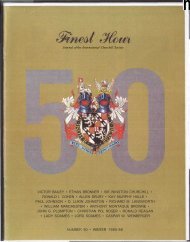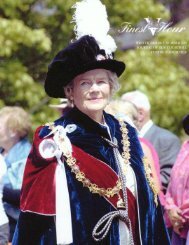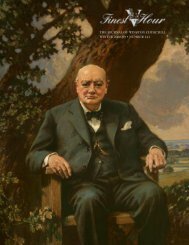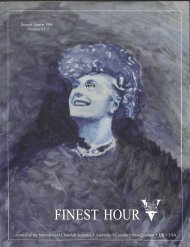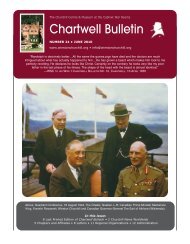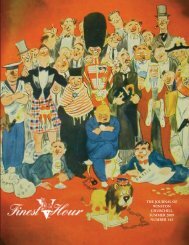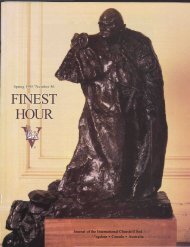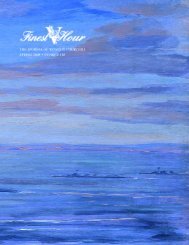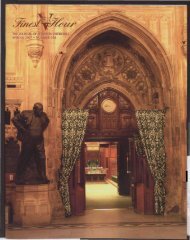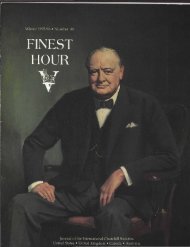Create successful ePaper yourself
Turn your PDF publications into a flip-book with our unique Google optimized e-Paper software.
CHURCHILLIANA<br />
THOSE REALISTIC HOLOGRAPH LETTERS<br />
Don’t be taken in—they look genuine, but they’re reproductions.<br />
JAMES MACK • SPECIMENS FROM THE MARK WEBER COLLECTION<br />
The first-known facsimile, dated 1945, was<br />
written to acknowledge congratulations following<br />
V-E Day and sympathy after <strong>Churchill</strong>’s party’s<br />
defeat in the 1945 General Election.<br />
utograph Letter Signed by <strong>Winston</strong> S.<br />
“A<strong>Churchill</strong>, British Prime Minister, on debossed<br />
House of Commons Notepaper, thanking a well-wisher for a<br />
kind message on his birthday, 1947. Folded once, slightly yellowed<br />
from age, otherwise a fine copy. $1200.” (This was an<br />
actual offer on the Internet, but the honest seller, alerted by<br />
an observer, conscientiously withdrew the item.)<br />
More than one seller or collector has been taken in by<br />
these remarkable facsimile holograph notes, produced by<br />
<strong>Churchill</strong>’s Private Office from 1945 through at least 1959—<br />
some of them so convincing that casual observers swear they<br />
are originals. But distinguishing one is easy: if there is no salutation,<br />
it’s a facsimile.<br />
The Private Office acted in self-defense. From the time<br />
<strong>Winston</strong> <strong>Churchill</strong> was thrown out of office in the July 1945<br />
General Election almost until the end of his days, letters,<br />
cards, and gifts flowed to Hyde Park Gate, Downing Street<br />
and Chartwell, attesting to the esteem in which he was held<br />
by ordinary people all over the world.<br />
So from time to time, his Private Office made him sit<br />
down with his big black pen and ink a note—sans salutation,<br />
<strong>Churchill</strong>’s birthday was always the signal for<br />
well-wishers around the world to send cards, letters<br />
and gifts. This 1947 facsimile has been personalized<br />
for the sender by the Private Office.<br />
This 1948 facsimile without embossment or return<br />
address probably accompanied books people<br />
sent to be autographed; after the war he became<br />
careful about the books he actually inscribed.<br />
sometimes dated, sometimes not—which they then reproduced<br />
by the thousands, thrust into envelopes and popped<br />
into the post. Write to Mr. <strong>Churchill</strong>, and chances were good<br />
you would get a “handwritten” reply!<br />
The reproductions, especially in the early days, were<br />
remarkably lifelike, the intensity of the dark blue ink varying<br />
with nib pressure, as it does normally. <strong>Churchill</strong>’s signature<br />
often bears his characteristic flourish, and looks as genuine as<br />
all get-out. Clearly these early examples were color separations,<br />
not simply black-printed reproductions.<br />
In the beginning, secretaries would often type the<br />
name and sometimes the address of the recipient (“Mr. A.<br />
Withers” in one example here) at the bottom of each note.<br />
But soon the workload prevented even this modest individualization.<br />
Through 1950, most notes bore an embossed<br />
House of Commons seal; when <strong>Churchill</strong> returned to office<br />
in 1951 they adopted a printed 10 Downing Street letterhead;<br />
after he retired they were headed from Chartwell. The<br />
last one he actually wrote may have been in 1959; after that<br />
his hand became very shaky and the notes were simply<br />
reprinted from previous ones, deleting the dates.<br />
FINEST HOUR 115 / 24



